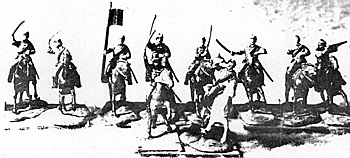 French Hussars from Airfix U.S. cavalry.
French Hussars from Airfix U.S. cavalry.
By the latter part of the century, breech loading and later on magazine rifles were putting quite a crimp an the tactical role of Cavalry. The Prussian staff Kniegspiel, in fact, had an automatic rule that cavalry could not hold position when exposed to fire at 700 yards, and could not normally be permitted even to pursue within 400 yards. Practically every nation acknowledged that cavalry could never make an impression on unshaken infantry.
Even so, no other am possessed the tactical mobility of the horse soldier. He was the eyes and ears of the army, and could not yet be replaced. Given, for the moment, a guaranteed role, cavalry officers maintained a strong preference for sword and lance and in keeping with their true role, i.e., "giving tone to what would otherwine be a vulgar brawl," they remained, on a whole, the most splendidly uniformed troops in the armies.
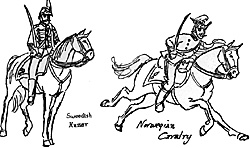 Since the 1870 period will be covered elsewhere,
reference to the French and Prussian horse will deal with post
1871 developments, which in the new German Empire, meant
lances. After 1887, every enlisted trooper in the German
cavalry got one. The infantry got Mauser's bolt Action magazine
rifles, the hussars, dragoons, and cuirassiers, the Saxon
Reiters and the Bavarian Chavauleger got a long hollow steel
tube with a point on the end of it and a pennon right below.
Since the 1870 period will be covered elsewhere,
reference to the French and Prussian horse will deal with post
1871 developments, which in the new German Empire, meant
lances. After 1887, every enlisted trooper in the German
cavalry got one. The infantry got Mauser's bolt Action magazine
rifles, the hussars, dragoons, and cuirassiers, the Saxon
Reiters and the Bavarian Chavauleger got a long hollow steel
tube with a point on the end of it and a pennon right below.
In France, the guard was abolished after Sedan, but the cuirassier, unlike his German counterpart, kept breastplate, sword, and revolver. Not until around the turn of the century was he permitted a three shot carbine. Hussars and chasseurs, giving up their former distinctions, wound up in sky blue with frogging white for hussars, black for chasseurs. In an heroic effort to overtake the German armament lead, all cavalry assigned to cavalry divisions received, shortly before World War I, a lance.
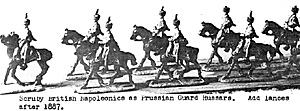 In theory, the cavalry was to ride out ahead of the
army and spar with the enemy horse, seeking to gain the
upper hand in order to threaten the march columns of the
enemy infantry, disrupt his artillery movements and
generally raise hell. Another theory one which made life in
wartime cavalry a very bad risk - concerned the use of
cavalry to slow up enemy infantry while friendly infantry
reformed after some disaster or other. It was unworkable
theory. After skulking around in the grass shooting at enemy
infantry, few troops would not be tempted to stop whatever
they had been doing and fire at a few squadrons of cavalry
advancing in close order.
In theory, the cavalry was to ride out ahead of the
army and spar with the enemy horse, seeking to gain the
upper hand in order to threaten the march columns of the
enemy infantry, disrupt his artillery movements and
generally raise hell. Another theory one which made life in
wartime cavalry a very bad risk - concerned the use of
cavalry to slow up enemy infantry while friendly infantry
reformed after some disaster or other. It was unworkable
theory. After skulking around in the grass shooting at enemy
infantry, few troops would not be tempted to stop whatever
they had been doing and fire at a few squadrons of cavalry
advancing in close order.
Although the cavalry was usually last to be equipped with a now shoulder arms and that weapon was usually a carbine, dismounted action was more and more considered necessary. Even cuirassiers and uhlans in Germany had the carbine. Bernhardi, though he maintained that the lance was the most vital cavalry weapon, insisted that cavalry be given an equal shoulder arm to the infantry. By 1914, this had been accomplished in the British and German armies.
Figures
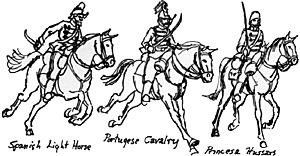 The regular union cavalry of the American Civil War
will make up into quite & number of European types of
about 1870-1900. Two factors, however, make looking
elsewhere a good idea on a number of colorful types. One
is that all Austrian cavalry during this period
wore sane form of pelisse, as did Prussian Guard Hussars,
Swedish Hussars, Danish Guard Hussars and a smattering of other
types. Moreover, on the second count, the Polish headgear had
become do rigeur for lances in England, Belgium, Prussia and
Austria (where uhlans had been deprived of the lance).
The regular union cavalry of the American Civil War
will make up into quite & number of European types of
about 1870-1900. Two factors, however, make looking
elsewhere a good idea on a number of colorful types. One
is that all Austrian cavalry during this period
wore sane form of pelisse, as did Prussian Guard Hussars,
Swedish Hussars, Danish Guard Hussars and a smattering of other
types. Moreover, on the second count, the Polish headgear had
become do rigeur for lances in England, Belgium, Prussia and
Austria (where uhlans had been deprived of the lance).
Numerous cossack types, not to mention Russian guards in marching dress, can be accomplished by putting British World War I heads on U.S. Cavalry bodies (Airfix) but the created helmets of the Austrian Dragoon, the fur busby of the Belgian Guide, the plumed helmet of the French cuirassier or dragoon, bearskin of the Scots Grays, and the like, are best recreated from Napoleonic figurines.
As a solution to the pelisse problem, smal1 paper cutouts hung over the left shoulder will do. On metal figures the pelisse may be artfully draped, glued on, sprayed with the figure for primer, and painted. For plastics, I recommend hanging the pelisse around the wearers neck with a piece of thread glued to the paper pelisse. Trying to glue paper to soft plastic is a very challenging but unrewarding endeavor.
German cavalry can be created from. Airfix World War I infantry heads on U.S. Cavalry bodies. Lances, of course, are the easiest of weapons to manufacture in 20 mm. A section of piano wire with a swallow tailed piece of paper is a lance. For plastic figures, it may be bettor to slip off the saber and heat the bottom end of the lance, ramming it through the sword hand of the figure.
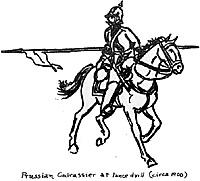 Prussian Cuirassier at lance drill (circa 1900)
Prussian Cuirassier at lance drill (circa 1900)
If you insist on carbines for your troopers, you are asking for trouble. Many metal figures and the Airfix U.S. cavalry are lacking in this respect. The tip end of a flat toothpick, painted brown with a silver strips on top to show where the barrel is and glued to a short length of thread will do, but not for all figures. With metal of course, you can glue the carbine either slung on the wearers back, or by his right side. lances too, am be slung, but by the time you have hung one each, lance and carbine on a figure, best glue him solidly to a base, handle him rarely, and then with extreme care.
Cavalry formed and fought by squadrons of about 100-150 troopers. These squadrons, nominally, were the equivalent formation to the infantry battalion, which outnumbered them about 7 to 1. A cavalry regiment of 4 squadrons, therefore, represented at 3 figures to 100, would muster 12 troopers, while an infantry battalion of 6-8 companies would have as many as 64 figures. Cutting it down, perhaps, to 3 figure to a company, 2 to a squadron may be move wieldy, but the disproportion was significant and should be kept in mind. A German cavalry division of 6 regiments numbered far fewer men than a brigade of 2 infantry regiments.
Uniform Notes
Swedish Hussars--Purplish dark blue coats, both pelisse and dolman, with black leather and plume, yellow trim and buttons, dark blue saddle cloth with yellow trim.
Norwegian Cavalry--Dark Green coat, medium blue trousers, both trimmed in red. Wet color on Saddle cloth and hat, metal white except for hat shield, band on saddle cloth and hat trim red. hat plume, if you can arrange for it, is black.
Spanish Princess Hussars--Beltleas white coat with black fur trim and yellow trim on pelisse. Cap is flat black, trousers light blue with yellow trim, belting black, blanket roll in front of saddle light blue, saddle bags light tan, cap cord yellow.
Spanish Lancer- Light Medium blue coat, blankets fore and aft or saddle. Red trousers with broad blue stripe, silver picklehaube with gold emblem and spike, tan saddle cloth, yellow top end orange bottom on pennon lance.
Spanish Light Horse--Light blue coat with black frogging, no belt at waist, red trousers with broad blue stripe, gold chevrons above red cuffs for officer, red top on kepi, white plume.
Portugese cavalry--Dark green coats with light blue trousers both with trim and frogging in red. Blanket rolls in a very light grey blue, metal and helmet trim gold, plume black. Ouffs red trimmed yellow, collar yellow.
Prussian Cuirassiers--White coat (no cuirass after 1887 except for some ceremonial occasions for guards) with trim in regimental colors. The regimental color (red for 2nd, dark blue 6th, yellow 7th,etc.) also carried on the field color of the saddle cloth. Silver helmet normally trimmed gold, reverse for officers of some regiments.
Prussian Dragoon--Light Prussian blue (with oils mix Prussian blue heavily with white) coat with dark grey trousers. Trim and belting according to regiment, saddlecloth being of coat color. Helmet black with metal trim according to regiment.
Hessian Dragoon- Dark green coat with white shoulder tabs, yellow buttons and strips down front of tunic. Yellow metal wreath and horse on front of helmet, yellow metal spike. Cuffs white. German lance penons are usually white topped and black on the bottom.
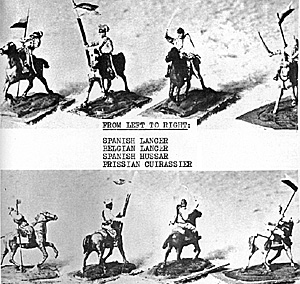
More Colorful Militarism
- Colorful Militarism Part 1: Infantry
Colorful Militarism Part 2: Cavalry
Colorful Militarism Part 3: Artillery
Back to The Armchair General Vol. 1 No. 2 Table of Contents
Back to The Armchair General List of Issues
Back to MagWeb Master Magazine List
© Copyright 1968 by Pat Condray
This article appears in MagWeb (Magazine Web) on the Internet World Wide Web. Other military history articles and gaming articles are available at http://www.magweb.com
